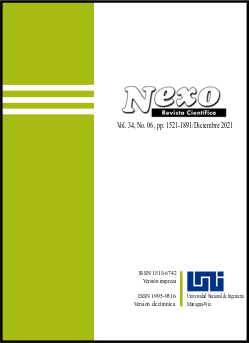Time distribution pattern of rainfall at Managua airport station, period 2002-2016
DOI:
https://doi.org/10.5377/nexo.v34i06.13120Keywords:
Hyetograph, Quartile, Pluviograph, Alternating Block Method, Rainfall probabilityAbstract
In the present paper is exposed the study of the rainfall patter distribution at Airport Managua pluviograph station. The study objective was determining the rainfall hyetographs and the advanced coefficients for the storm at each quartile, in the period 2002-20016. The rainfall accumulated curve mass were estimated for the storms with depth greater than 20 mm and duration less or equal to two h. The rainfall accumulated curve mass were normalized with respect theirs duration and precipitation depth. Forward, the rainfall distribution pattern were obtained for the storms with depth greater than 20 mm and for the storms with depth greater than 30 mm, which could be used for the estimates of maximum discharges to determines floods at Managua airport station influence area. The study suggests that the rainfall distribution patter obtained en both cases, it is not symmetric and differs from that obtained with the alternate blocks method.
Downloads
1470
Downloads
Published
How to Cite
Issue
Section
License
Copyright (c) 2021 Universidad Nacional de Ingeniería

This work is licensed under a Creative Commons Attribution 4.0 International License.
The authors who publish in Nexo Scientific Journal agree to the following terms:
- Authors retain the copyright and grant the journal the right of the first publication under the license Creative Commons Attribution License, which allows others to share the work with a recognition of the authorship of the work and the initial publication in Nexo Scientific Journal.
- Authors may separately establish additional agreements for the non-exclusive distribution of the version of the work published in the journal (for example, in an institutional repository or a book), with the recognition of the initial publication in Nexo Scientific Journal.
- Authors are allowed and encouraged to disseminate their works electronically (for example, in institutional repositories or in their own website) before and during the submission process, as it can lead to productive exchanges, as well as earlier and greater citation of published works.










